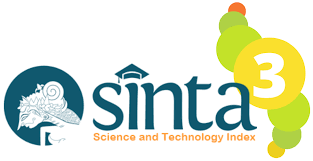Refleksi Perempuan Arab Modern dalam Film Barakah Yuqobil Barakah
DOI:
https://doi.org/10.30957/lingua.v18i2.720Keywords:
Saudi Arabia, film, modernity, womenAbstract
This study aims to reveal the portrait of modern Arab women in the film Barakah Yuqobil Barakah, as well as to explain the discourse of modernity in Saudi Arabia based on Pierce's perspective. This research is a qualitative descriptive study. The data collection technique used was the observation and note technique. Researchers used descriptive analysis techniques based on Miles and Huberman's models, namely; data reduction, data presentation, and conclusions. The results showed that the icons, indexes, and symbols related to the modern portrait of Saudi Arabian women. The icons that appear are social media as a reflection of technological progress, and the ideal(body-body goals) as a reflection of modern women. Meanwhile, the index that appears is the Karakoza brand as a reflection of independent and modern entrepreneurial freedom. The symbols that appear are the open style of clothing, Brand ambassadors, and celebrities which are symbols of modernity experienced by aunts as Arab women. Within the frame of the media, film as a cybertext becomes a value-free space for readers to construct discourses conveyed by the authors.
Downloads
References
Alamsyah, I. E. (2021). Alhamdulillah, Pusat Bisnis Perempuan Saudi Telah Dibuka. Republika.Co.Id. https://www.republika.co.id/berita/internasional/timur-tengah/nbxtpj-alhamdulillah-pusat-bisnis-perempuan-saudi-telah-dibuka.
Anthony, G. (2003). The Third Way and its critiques. Ircisod.
Ashfiasari, S. & M. T. W. (2021). Analisis Semiotika Film the Social Dilemma. NOUMENA: Jurnal Ilmu Sosial Keagamaan, 1(02), 44–54.
Azis, J. &. (2018). Penyingkapan CitraPerempuan Cerpen Media Indonesia: Kajian Feminisme. Lingua, 15(02), 71–82.
Barker, C. (2004). Culture Studies. Kreasi Wacana.
Brown, J. (2019). Apa saja bukti pengaruh media sosial kehidupan Anda. Bbc Indonesia. https://www.bbc.com/indonesia/vert-fut-42679432
Cobey, P. & L. J. (2002). Mengenal Semiotika For Beginners. Mizan.
Danesi, M. (2013). Encyclopedia of Media and Communication. University of Toronto Press.
Dewi, Rosinawati; Sarwiji Suwandi, & E. T. S. (2018). Kesantunan Guru dan Siswa Perempuan dalam Pembelajaran Bahasa Indonesia di Sekolah Bilingual. Lingua, 15(02), 147–162.
Gabriella Adipoetra, F. (2016). Representasi Patriarki dalam Film “Batas.†Jurnal E- Komunikasi, 4(01).
Hasanah, U. (2016). Konvergensi antara Tradisi dan Modernitas pada Majlis Taklim Perempuan di Jakarta. Jurnal Studi Gender Dan Anak, 3(02).
Kamahi, U. (2017). Teori Kekuasaan Michel Foucault: Tantangan Bagi Sosiologi Politik. Jurnal Al-Khitabah, 3(01).
Kamaruddin, Lalu., Syahdan., & J. M. (2019). Kode Lakuan Perempuan dalam Naskah Qurtubi Karya TGH. Alimuddin Praya Nusa Tenggara Barat. Lingua, 16(02), 247–270.
Kurniawan, K. (2018). Metode Penelitian Bahasa dan Sastra Indonesia. Pustaka Setia.
Margit, A. (2020). Media Sosial jadi Pelarian Anak Muda Arab Saudi. Bbc Indonesia. https://kabar24.bisnis.com/read/media-sosial-jadi-pelarian-anak-muda-arab-saudi
Mulyana, A. P. & M. I. (2020). Makna Simbol Isi Peras Di Tengah Era Moderenisasi Zaman (Analisis Semiotika Charles Sander Pierce Pada Persyaratan Ritual Masyarakat The Sun. Jurnal Ilmu Komunikasi AKRAB, 5(01), 1–14.
Puspitasari, D. R. (2021). Nilai Sosial Budaya dalam Film Tilik (Kajian Semiotikacharles Sanders Peirce). Jurnal SEMIOTIKA, 15(01), 10–18.
Putri, N. W. E. (2019). Semiotika Pierce pada Film Dokumenter ‘Sexy Killers.’ Jurnal Maha Widya Duta, 2(02), 89–100.
Ritzer, George dan Goodman, D. J. (2007). Teori Sosiologi Modern. Kencana Prenada Media Group.
Ritzer, G. (2005). Teori Sosial Postmodernisme. Kreasi Wacana.
Ritzer, G. (2012). Teori Sosial. Nusa Media.
Roxborough, S. (2019). Oscars: Saudi Arabia Selects “Barakah Meets Barakah†for Foreign-Language Submission. Hollywoodreporter. https://www.hollywoodreporter.com/news/oscars-saudi-arabia-selects-barakah
Rusmana, D. (2014). Filsafat Semiotikaa (Paradigma, Teori, dan Metode Interpretasi Tanda: Dari Struktural hingga Dekonstruksi Praksis). CV Pustaka Media.
Shokshok, Sara Mostafa., & R. N. I. (2019). Figure of Speech Representing Religious Education Values in Moustafa Akkad’s The Message. Lingua, 16(01), 1–14.
Siswanto, V. A. (2012). Research Strategy and Steps. Graha Ilmu.
Sobur, A. (2006). Semiotika Komunikasi. PT Remaja Rosdakarya.
Sugiyono. (2008). Metode Penelitian Pendidikan Pendekatan Kuantitatif, Kualitatif, R&D. Alfabeta.
Susanti, D. & M. I. R. (2020). Konstruksi Relasi Seksual Laki-Laki di Indonesia dalam Film (Studi Semiotika dalam Film Arisan! (2003) Sutradara Nia Dinata). MEDIALOG: Jurnal Ilmu Komunikasi, 3(02), 65–84.
The Global Gap Gender Report 2019. (2019). Weforum. https://reports.weforum.org/global-gender-gap-report 2019
Vera, N. (2014). Semiotika Dalam Riset Komunikasi. Ghalia Indonesia.
Visi 2030. (n.d.). Retrieved July 13, 2021, from https://www.visi2030.gov.sa/en/
Wibowo. (2006). Semiotika: Aplikasi praktis bagi penelitian dan penulisan skripsi mahasiswa ilmu komunikasi. Mitra Wacana Media.
Zaimar, O. K. (2008). Semiotik dan penerapannya dalam karya sastra.
Downloads
Published
How to Cite
Issue
Section
License
Authors who publish with this journal agree to the following terms:
- Authors retain copyright and grant the journal right of first publication with the work simultaneously licensed under a Creative Commons Attribution-ShareAlike 4.0 International License that allows others to share the work with an acknowledgement of the work's authorship and initial publication in this journal.
- Authors are able to enter into separate, additional contractual arrangements for the non-exclusive distribution of the journal's published version of the work (e.g., post it to an institutional repository or publish it in a book), with an acknowledgement of its initial publication in this journal.
- Authors are permitted and encouraged to post their work online (e.g., in institutional repositories or on their website) prior to and during the submission process, as it can lead to productive exchanges, as well as earlier and greater citation of published work (See The Effect of Open Access).















